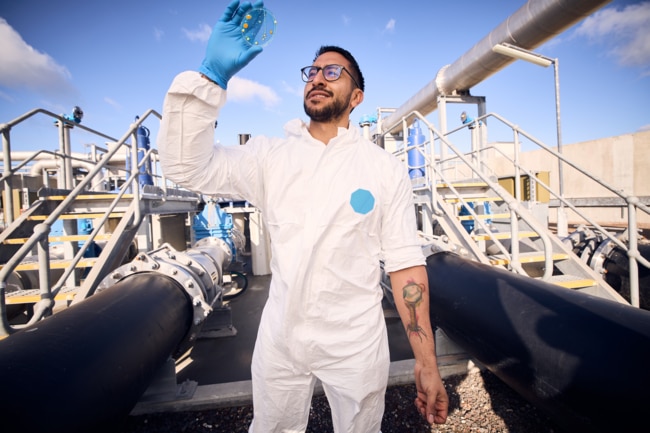Last Chance to Save a Life: unearthing viral clues to disease
An Australian series follows patients as they undergo phage therapy, a rare, unusual and little-known bacterial treatment.

Last Chance To Save A Life may be a rather awkward title but it’s another compelling story of love, hope and fear from Sonya Pemberton’s Genepool Productions, which specialises in telling stories of science for Australian and global audiences. And dramatising them in such a way as to humanise their complex narratives at a time when science faces sustained and often enraged opposition.
Pemberton likes to think of herself, she says, as “a translator of science’’, digging into seemingly impenetrable ideas and research, in a time when, following the pandemic, there’s still an erosion of public trust in science. The denialism, scepticism, fear, and trepidation around it is increasingly exacerbated by political polarisation and social media, ideas cherrypicked and mischaracterised to push social and political agendas.
Her approach then is to embrace the art of storytelling and empathetically share the journey that the subjects of her films are going through and to discuss ideas in her films in ways that straddle both journalism and entertainment.
She’s won more than 80 awards for her films, including an Emmy award for Outstanding Science, and a record-breaking five Eureka Prizes for Science Journalism. She and her company pride themselves on making complex science stories accessible to broad audiences, with films like Jabbed – Love Fear and Vaccines, Immortal, Uranium – Twisting the Dragon’s Tail, and Carbon – The Unauthorised Biography and more.
Her slant is through research to distil a few key ideas, to “find imaginative and unexpected ways to incite curiosity, avoid signalling which ‘side’ you are on, tell your story with passion but avoid the triggers that spark conflict and shut down useful conversation.”
And certainly, Last Chance To Save A Life is told with passion, exploring not just the rising threat of superbugs and the explosion in infections from antibiotic-resistant bacteria but the exciting potential of what is called phage therapy. Once regarded as a potential treatment for infections it was then largely forgotten but now, if still controversial, is suddenly gaining heightened interest. Known for decades as “the forgotten cure” phage therapy once had some credibility for having saved the life of Hollywood legend Tom Mix before being abandoned by Western science.
As this film illustrates phages, formally known as bacteriophages, are viruses that solely kill and selectively target bacteria. Unlike other viruses that make you sick, they can only infect bacteria. It seems they’re one of the most common biological entities in nature, and are found wherever bacteria exist, in the soil, deep within Earth’s crust, inside plants and animals, and even in the oceans.
Like the technology, it’s a fascinating subject, the stuff of high drama, especially while it’s attempted only after all conventional treatments have failed. The dedicated physicians she covers in the film are racing to win arrival for phage therapy before superbugs exhaust the last drug in the medical arsenal. Can they beat the clock?
And as was the case with Pemberton’s brilliant Catching Cancer, this new film also works as a low-key kind of medical thriller: mystery, tragedy and a close-up view of scientific medical issues and procedures. The focus is on the diagnosis and treatment of rare diseases and conditions, the thrill emerging from uncovering the answer in time – or not.
Pemberton is executive producer, the film produced by the experienced Anna Mantzoros who has worked across many factual genres on shows as eclectic as Grand Designs Australia, Shaun Micallef’s Newstopia and MasterChef. More recently she line-produced the interview series The ABC Of … with David Wenham. Emma Watts is the director and has created content for Discovery Science, BBC, Hulu, CNN, NBC, Discovery ID, The World Science Festival and every Australian network and broadcaster.
Pemberton says that for several years, her Genepool Productions team had been exploring making a film on the rising threat of superbugs and the potential of phage therapy but had not found the right angle to carry the tale
Then Watts suggested an original take as the first Victorian phage therapy trial was about to start in Melbourne. What if Pemberton’s team were to follow the scientists and patients through the highs and lows of dealing with urgent superbug infections and, in real time, reveal the challenges and promise of this therapy?
The film is built around Watts’s intimate access to three people, long suffering patients, for whom conventional medical options are no longer an option, and the doctors who are trying to save them. Bacteria has invaded their bodies and specific antibiotics have lost their ability to kill or stop their growth.
As Watts reveals it’s a wider story of the way that the increased prevalence of bacteria that are resistant to most or all available antibiotics is precipitating a major health crisis. The development of new antibiotics is an expensive and time-consuming process, and consequently scientists are seeking alternative antimicrobial strategies.
Resistant bacteria can survive in the presence of the antibiotic and continue to multiply causing longer illness or even death. Infections may require more care as well as alternative and more expensive antibiotics, which may have more severe side effects.
Last Chance to Save a Life follows two parallel narratives – the ticking clock drama as scientists seek to tame the viruses’ wild nature, and the intimate stories of patients fighting for their lives. Each patient is out of conventional medical options, so they will be injected with trillions of phages in the hope they can defeat their bacterial enemy. No-one knows if this radical approach will work.
Ilario is a positive 22-year-old diagnosed as a child with life-limiting cystic fibrosis affecting his lungs, but they were then colonised by a superbug when he was aged 10, much of his life spent in hospitals as doctors battled to keep it under control. “It can be scary to live with,” he says in his optimistic but patient way.
Paul Laszlo is a professional musician, his bass rarely out of sight, who has battled mesothelioma, an asbestos-related cancer only on recovery to learn doctors had discovered a seemingly untreatable bacterial infection in his chest bringing him to the brink of death. “It’s Custer’s Last Stand,” he says of his phage therapy. He’s determined not to be “just a blob in a bed.”
Naomi Creek, a cheerful soul, lives on beautiful Flinders Island, a place they say where hurry happens somewhere else, but is haunted by a leg infection that likely will lead to an amputation. Her last chance to keep it is to access the phage therapy trial in Melbourne.
Then there are the doctors, led by Jeremy Barr and Fernando Gordillo Altamirano; young scientists haunted by the grim reality of untreatable superbugs. Fuelled by an unwavering determination, they join teams of experts to harness the power of phages as the clock ticks for their patients. And there’s Professor Anton Peleg and Professor Jon Iredell, in charge of the departments attempting to harness the power of phages, as Iredell says, “hopeful of sending this specific predator after very specific prey”.
As Watts says, no-one had any real idea what would happen in these trials.
“We didn’t know who these patients might be, when they would arrive, if they would agree to a documentary crew following their stories, nor what would happen to them after they were injected with trillions of viruses. The stakes couldn’t have been higher for the people we followed, and it’s no exaggeration to say this trial was their last chance to live.”
The multiple stories are tied together by the empathetic narration of actor and writer Faustina Agolley who in her quietly withheld way adds depth and emotion to the narrative without being intrusive, creating juts the right immersive experience. And it’s superbly filmed by a group of cinematographers led by Aaron Smith who shot the recent feature documentary John Farnham: Finding The Voice, now the highest grossing Australian feature documentary ever, and Dale Cochrane who shot the recent documentary series Folau.
Their images not only give a sense of “being there” in the observational sense but, under some extreme emotional pressure, they still manage to find images that surprise and reinforce the developing drama.
Last Chance To Save A Life, Thursday, 8.30pm, SBS




To join the conversation, please log in. Don't have an account? Register
Join the conversation, you are commenting as Logout